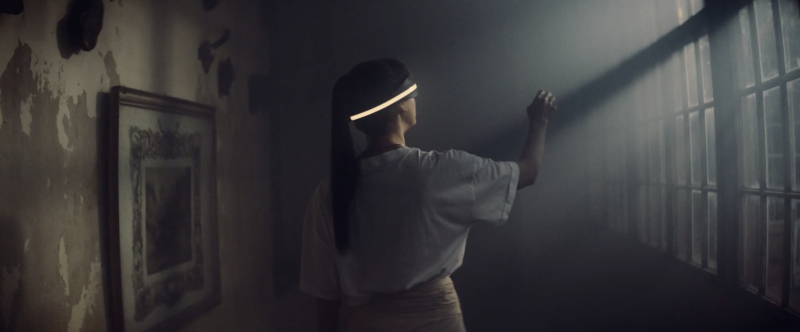Bonobo – Fragments
The visualisers for the music from British producer Bonobo’s seventh album, Fragments, have all played with the dynamics of light as it interacts with the natural world. For Rosewood, one of the album’s first singles, the ocean and a mountain coastline blur into a singular wormhole. For Tides (and Fragments as a whole on Spotify), the album cover comes to life; kaleidoscopic depths churn and tumble, cornflower blue and glowing highlights in sunset hues. Speaking on the album, Bonobo (aka Simon Green) revealed how he found his inspiration both in nature and on the dancefloor. “I remembered all over again how much I loved crowds and movement and people connecting with each other,” he said of this inspiration, finding a metaphor for the flux of the dancefloor in dappled light on swaying trees and undulating water. This preoccupation tracing the refraction of light and its (yes) fragments as it interacts with the world suggested Bonobo might be on to something more nebulous than before.
Known for languid and often overwrought pieces, he’s become synonymous with a style of downtempo that notoriously lapses into “safe” territory. This safety has always been Bonobo’s achilles heel. He’s undeniably skilled, and this prowess has made it impossible not to fixate on where he’s capable of pushing his sound if he tries. His manifesto of using “electronic methods to make non-electronic music” isn’t singular; it’s a sentiment shared by pioneers of the downtempo movement. Some might argue that Bonobo himself belongs to this ilk. But whereas peers like Four Tet and Nicholas Jaar took the post-rave groundwork laid by the likes of Röyksopp and Lemon Jelly to new and increasingly more distinctive places, Bonobo has ridden the wave of downtempo from its crest into the establishment of its mainstream trends (like this). And he’s remained there. While 2010’s breakout album Black Sands, which fused jazz and big band percussion with Bonobo signatures, hinted at a promising evolution, 2014’s Migration took Bonobo right back to the start again (Pitchfork loved it, though). Then of course there’s his infamous fabric presents turn in 2019, which left many confused but also wondering if this was the first sign of Bonobo finally breaking his own boundaries. Such was the expectation going into Fragments, only intensified by the release of uncharacteristically genre bending singles like Otomo and Ninja Tune’s touting of the album as “his masterpiece.”
Download and stream Fragments here
Finally here in its final form, Fragments sort of lives up to the hype. It’s almost the shift we’ve wanted from him. The album sees Bonobo exploring new places, but on familiar waters. The course might be uncharted for him, but it’s one that’s been taken many times before. Fragments gets swept up in the currents of existing tropes rather than plunging just a touch deeper. This makes the album, while impeccably crafted and undeniably beautiful, frustratingly hackneyed. The potential for Fragments to turn the tides for Bonobo is massive, but never quite gets there. The opening one-two-punch of Polyghost, a prologue melting instrumentalist Miguel-Atwood Furguson’s plucked harp and violin strings with shudders of bass and churning electronics, surging seamlessly into the bleeping intro of Shadows is a beguiling start. Shadows peters along carefully, wrapping itself around Jordan Rakei’s vocals. To Bonobo’s credit, he’s always had a knack for working with the best vocalists for his music’s direction. Rakei works wonderfully on Shadows, recalling the tonality of the style most recently popularised by Rüfüs Du Sol. The same can be said for Jamila Woods on the slow burning trip-hop of Tides, which bends entirely to the will of her siren song. Tracks like the tech-house informed Rosewood and the tribal garage and bass of Otomo (co-produced with O’Flynn) are amongst the most propulsive and satisfying on the record. The latter remains a standout, and the most distinct step toward something original that Bonobo takes on Fragments. Otomo pushes the Bonbo aesthetic into a direction that feels natural in the scope of his recent expeditions, almost making sense of that fabric presents tenure. More moments which manage to fuse Bonobo with the potential future of his sound exist elsewhere, but they’re fleeting. There’s something intriguing about the tech-house of Counterpart and jungle leaning Sapien. But just as these tracks begin to enter the exciting sorts of places we expected from Fragments, they dissipate into the ether, flickering out like beams of sunlight dancing on choppy waters.
Perhaps there was too much being expected of Bonobo, and perhaps the promotional cycle lauding Fragments as “the hardest and most hip-shaking grooves that Green has ever created” is mostly to blame. On surface level, it does suggest a natural progression. It’s definitely a course correction from Migration, and the closet we’ve got to a Black Sands successor. With its myriad of style and aesthetic influences from UK rave to deep house, the album opens up an ocean of possibility for wherever he chooses to go next, and hopefully that place will dive deeper. If anything, Bonobo has been getting his feet wet when it’s really been time to take the full plunge.
Watch the music video for Otomo from Fragments below.
Follow Bonobo
Facebook | Twitter | Instagram | SoundCloud | Website




